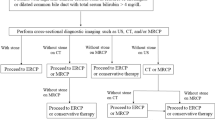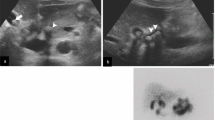Abstract
Background
We determined the accuracy of combined unenhanced and contrast-enhanced helical computed tomography (CT) for diagnosis of bile duct stones.
Methods
During a 12-month period, 1090 patients who underwent combined CT and endoscopic retrograde cholangiography (ERC) or percutaneous transhepatic cholangioscopy (PTC) were enrolled in this study. The results of prospective CT interpretation regarding the presence of bile duct stones were compared with results of endoscopic stone removal, PTC and with surgical results. In 70 patients, detectability of stones on CT was evaluated depending on stone types.
Results
Of 1090 study patients, 175 and 299 patients were confirmed to have intrahepatic and common duct stones, respectively. The sensitivity and specificity of combined CT were 73% and 98% for diagnosis of intrahepatic stones and 71% and 97% for common duct stones. Of 70 patients 24, 25, and 21 patients had cholesterol, black pigment, and brown pigment stones, respectively. Eleven of 24 cholesterol stones, 21 of 25 black pigment stones, and 15 of 21 brown pigment stones were detected on combined CT.
Conclusion
Combined CT is of limited sensitivity for detection of bile duct stones, especially in Western countries where cholesterol stones predominate. It may be of greater value in populations with a higher incidence of pigment stones. Other complementary imaging modalities are needed for patients with negative CT findings who are highly suspected to have biliary stones.




Similar content being viewed by others
References
Jeffrey RB, Federle MP, Laing FC, et al. (1983) Computed tomography of choledocholithiasis. AJR 140:1179–1183
Baron RL, Stanley RJ, Lee JKT, et al. (1983) Computed tomographic features of biliary obstruction. AJR 140:1173–1178
Baron RL (1987) Common bile duct stones: reassessment of criteria for CT diagnosis. Radiology 162:419–424
Soto JA, Alvarez O, Munera F, et al. (2000) Diagnosing bile duct stones: comparison of unenhanced helical CT, oral contrast-enhanced CT cholangiography, and MR cholangiography. AJR 175:1127–1134
Cronan JJ, Mueller PR, Simeone JF, et al. (1983) Prospective diagnosis of choledocholithiasis. Radiology 146:467–469
Gross BH, Harter LP, Core RM, et al. (1983) Ultrasonic evaluation of common bile duct stones: prospective comparison with endoscopic retrograde cholangiopancreatography. Radiology 146:471–477
Laing FC, Jeffrey RB (1983) Choledocholithiasis and cystic duct obstruction: difficult ultrasonographic diagnosis. Radiology 146:475–479
Laing FC, Jeffrey RBJ, Wing VW (1986) Improved visualization of choledocholithiasis by sonography. AJR 143:949–952
Varhgese JC, Liddell RP, Farrell MA, et al. (2000) Diagnostic accuracy of magnetic resonance cholangiopancreatography and ultrasound compared with direct cholangiography in the detection of choledocholithiasis. Clin Radiol 55:25–35
Pickuth D, Spielmann RP (2000) Detection of choledocholithiasis: comparison of unenhanced spiral CT, US, and ERCP. Hepatogastroenterology 47:1514–1517
Chan YL, Chan ACW, Lam WWM, et al. (1996) Choledocholithiasis: comparison of MR cholangiography and endoscopic retrograde cholangiography. Radiology 200:85–89
Regan F, Fradin J, Khazan R, et al. (1996) Choledocholithiasis: evaluation with MR cholangiography. AJR 167:1441–1445
Soong TCL, Lee RC, Cheng HC, et al. (1998) Dynamic MR imaging of hepatolithiasis. Abdom Imaging 23:515–519
Gabata T, Kadoya M, Matsui O, et al. (2000) Intrahepatic biliary calculi: correlation of unusual MR findings with pathologic findings. Abdom Imaging 25:266–268
Kubo S, Hamba H, Hirohashi K, et al. (1997) Magnetic resonance cholangiography in hepatolithiasis. Am J Gastroenterol 92:629–632
Neitlich JD, Topazian M, Smith RC, et al. (1997) Detection of choledocholithiasis: comparison of unenhanced helical CT and endoscopic retrograde cholangiopancreatography. Radiology 203:753–757
Baron RL (1997) Diagnosing choledocholithiasis: how far can we push helical CT? Radiology 203:601–603
Cuenca IJ, Martinez LO, Homs MP (2001) Helical CT without contrast in choledocholithiasis diagnosis. Eur Radiol 11:197–201
Brink JA, Kammer B, Mueller PR, et al. (1994) Prediction of gallstone composition: synthesis of CT and radiographic features in vitro. Radiology 190:69–75
Bova JG, Schwesinger WH, Kurtin WE (1992) In vivo analysis of gallstone composition by computed tomography. Gastrointest Radiol 17:253–256
Stockberger SM, Wass JL, Sherman S, et al. (1994) Intravenous cholangiography with helical CT: comparison with endoscopic retrograde cholangiography. Radiology 192:675–680
Van Beers BE, Lacrosse M, Trigaux JP, et al. (1994) Noninvasive imaging of the biliary tree before or after laparoscopic cholecystectomy: use of three-dimensional spiral CT cholangiography. AJR 162:1331–1335
Sandstad O, Osnes T, Skar V, et al. (1994) Common bile duct stones are mainly brown and associated with duodenal diverticula. Gut 35:1464–1467
Sandstad O, Osnes T, Skar V, et al. (2000) Brown pigment stones in the common bile duct: reduced bilirubinate diconjugate bile. Scand J Gastroenterol 2:198–203
Brakel K, Lameris JS, Nijs HGT, et al. (1990) Predicting gallstone composition with CT: in vivo and in vitro analysis. Radiology 174:337–341
Janowitz P, Zoller A, Swobodnik W, et al. (1990) Computed tomography evaluation of radiolucent gallstones in vivo. Gastrointest Radiol 15:58–60
Bernhoft RA, Pellegrini CA, Motson RW, et al. (1984) Composition and morphologic and clinical features of common duct stones. Am J Surg 148:77–85
Baron RL, Rohrmann CA Jr, Lee SP, et al. (1988) CT evaluation of gallstones in vitro: correlation with chemical analysis. AJR 151:1123–1128
Nakayama F, Furusawa T, Nakama T (1980) Hepatolithiasis in Japan; present status. Am J Surg 139:216–220
Choi TK (1989) Intrahepatic stones. Br J Surg 76:213–214
Saunders KD, Cates JA, Roslyn JJ (1990) Pathogenesis of gallstones. Surg Clin North Am 70:1197–1216
Nakayama F, Koga A (1984) Hepatolithiasis: present status. World J Surg 8:9–14
Kim MH, Sekijima J, Park HZ, et al. (1995) Structure and composition of primary intrahepatic stones in Korean patients. Dig Dis Sci 40:2143–2151
Kim MH, Sekihima J, Lee SP (1995) Primary intrahepatic stones. Am J Gastroenterol 90:540–548
Yarmuch J, Csendes A, Diaz JC, et al. (1989) Results of surgical treatment in patients with “Western” intrahepatic lithiasis. Hepatogastroenterology 36:128–131
Pausawasdi A, Watanapa P (1997) Hepatolithiasis: epidemiology and classification. Hepatogastroenterology 44:314–316
Ker CG, Huang TJ (1981) Intrahepatic stones; etiological study. J Formosan Med 80:698–711
Min PC, Cho MH, Im HM, et al. (1966) Biliary tract disease among Koreans. Analysis of 100 consecutive cases. J Korean Surg Soc 8:1–7
Menu Y, Lorphelin JM, Scherrer A, et al. (1985) Sonographic and computed tomographic evaluation of intrahepatic calculi. AJR 145:579–583
Yamashita N, Yanagisawa J, Nakayama F (1988) Composition of intrahepatic calculi-etiological significance. Dig Dis Sci 33:449–453
Kobayashi A, Tanimura H (1984) Chemical analysis of intrahepatic gallstones. J Biliary Tract Pancreas 5:1609–1613
Mukaihara S (1981) Chemical analysis of gallstones. classification and composition of human gallstones. Arch Jpn Chir 50:476–500
Lim JH (1991) Oriental cholangiohepatitis: pathologic, clinical and radiologic features. AJR 157:1–8
Acknowledgment
We thank Bonnie Hami, Department of Radiology, University Hospital of Cleveland, for her editorial assistance in the preparation of this manuscript.
Author information
Authors and Affiliations
Corresponding author
Rights and permissions
About this article
Cite this article
Lee, J.K., Kim, T.K., Byun, J.H. et al. Diagnosis of intrahepatic and common duct stones: Combined unenhanced and contrast-enhanced helical CT in 1090 patients. Abdom Imaging 31, 425–432 (2006). https://doi.org/10.1007/s00261-006-9076-1
Received:
Accepted:
Published:
Issue Date:
DOI: https://doi.org/10.1007/s00261-006-9076-1




